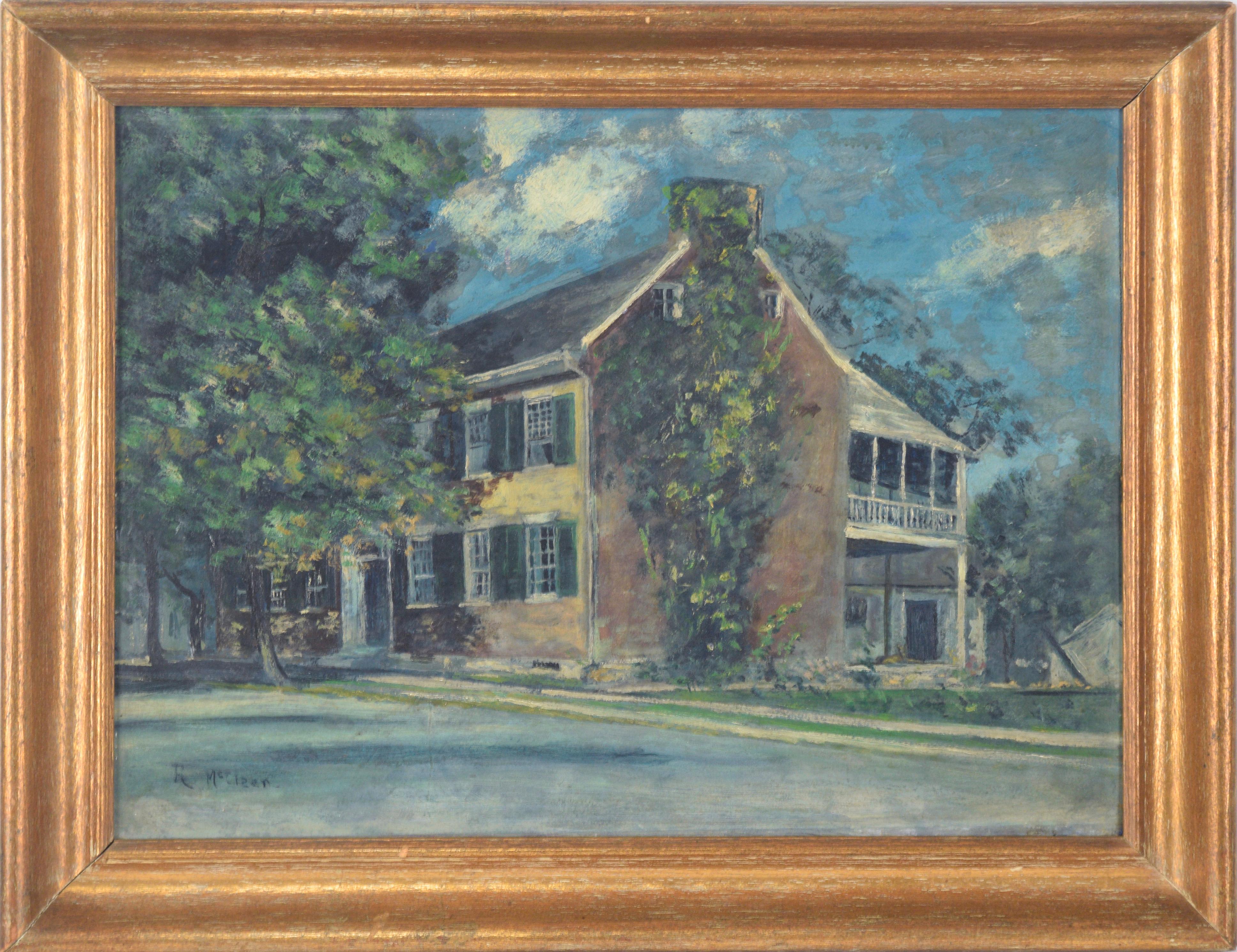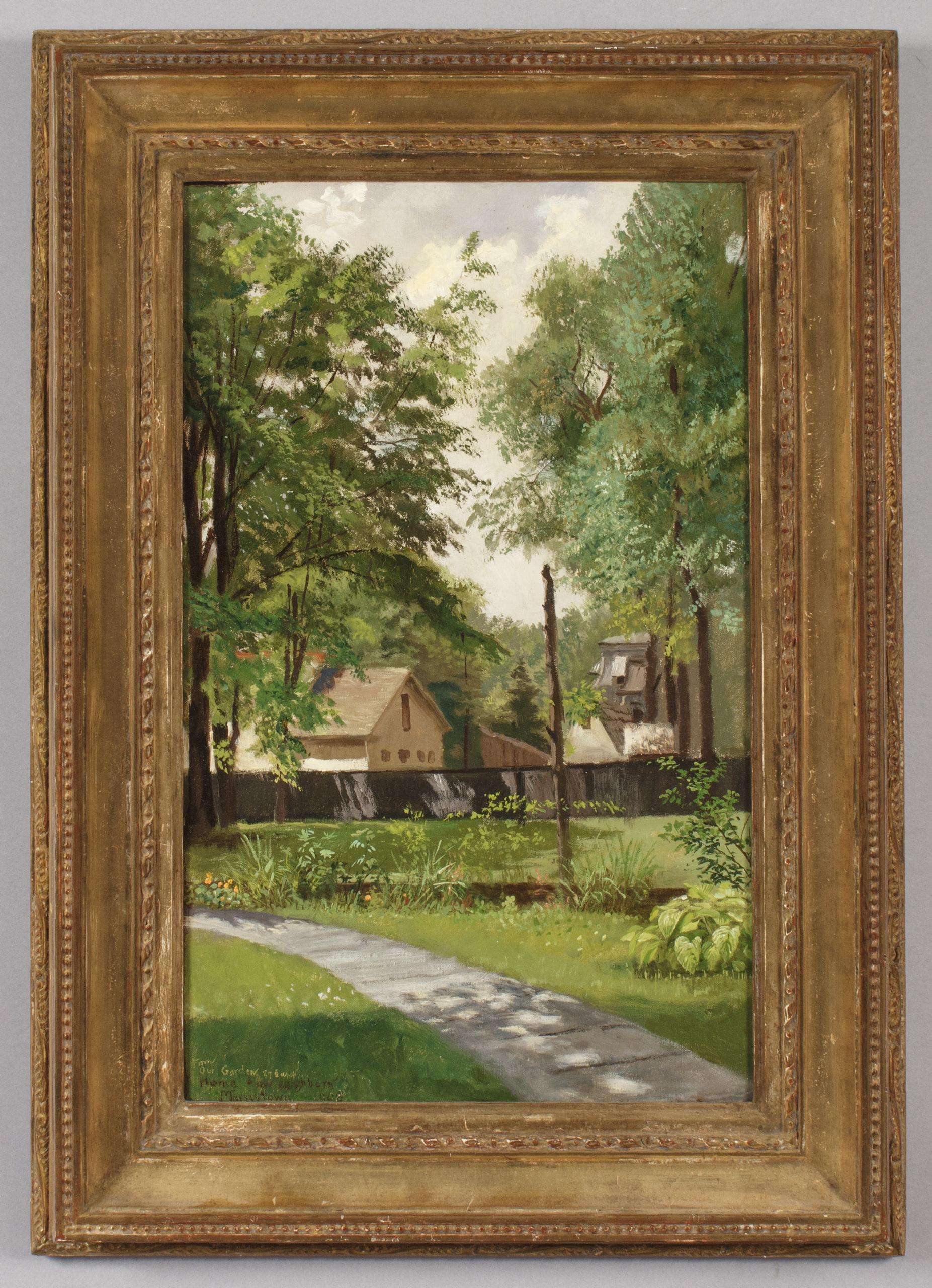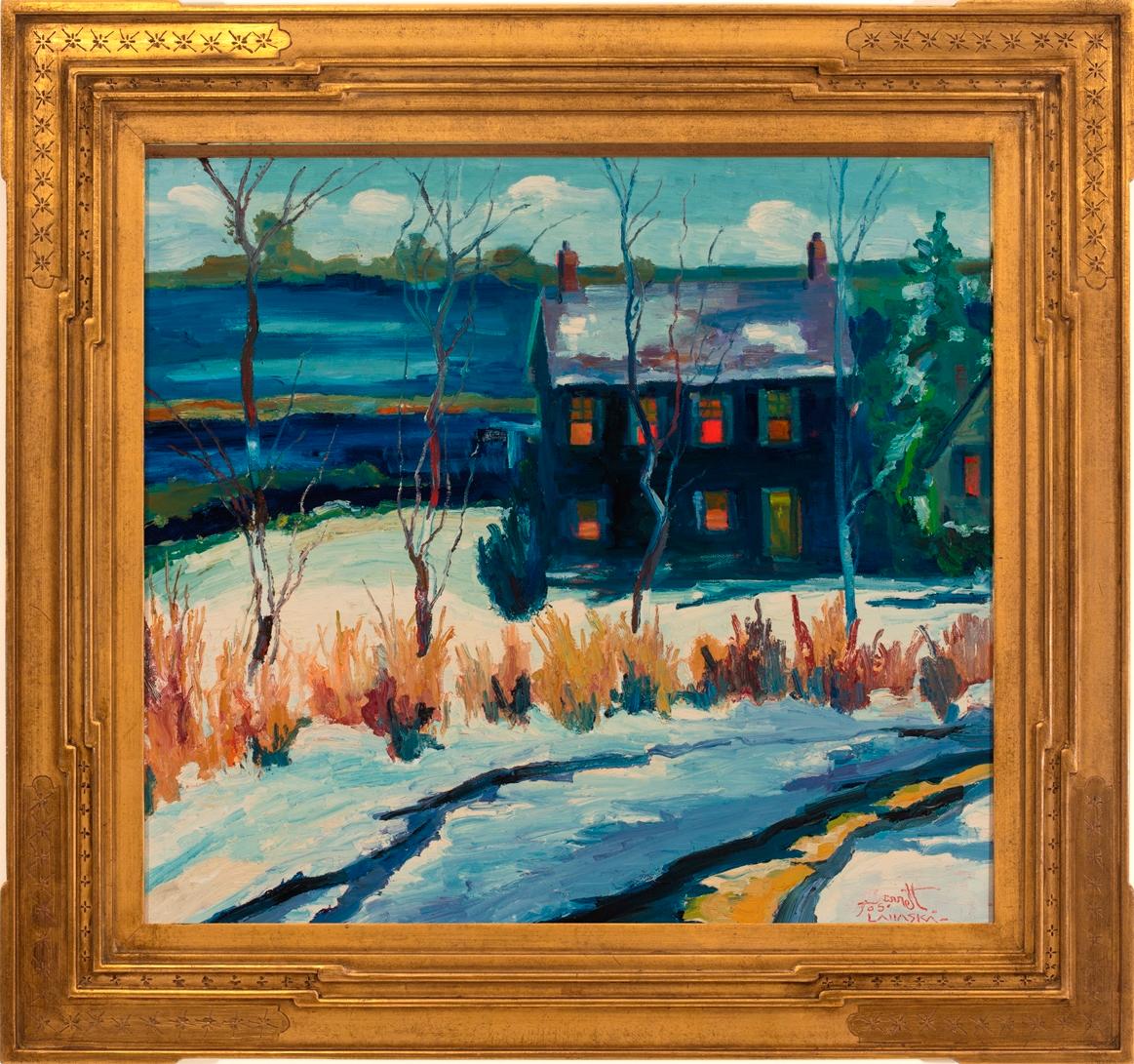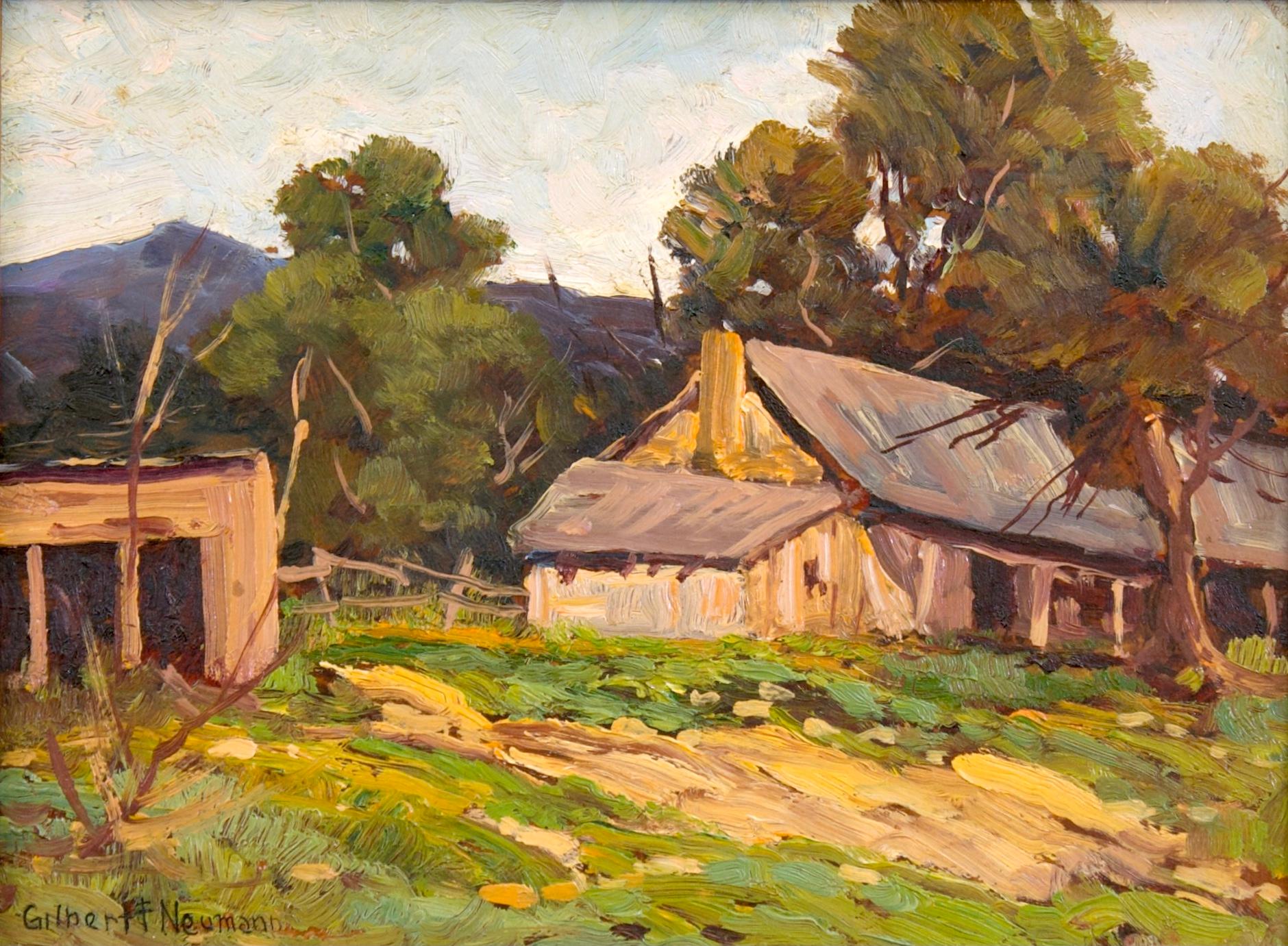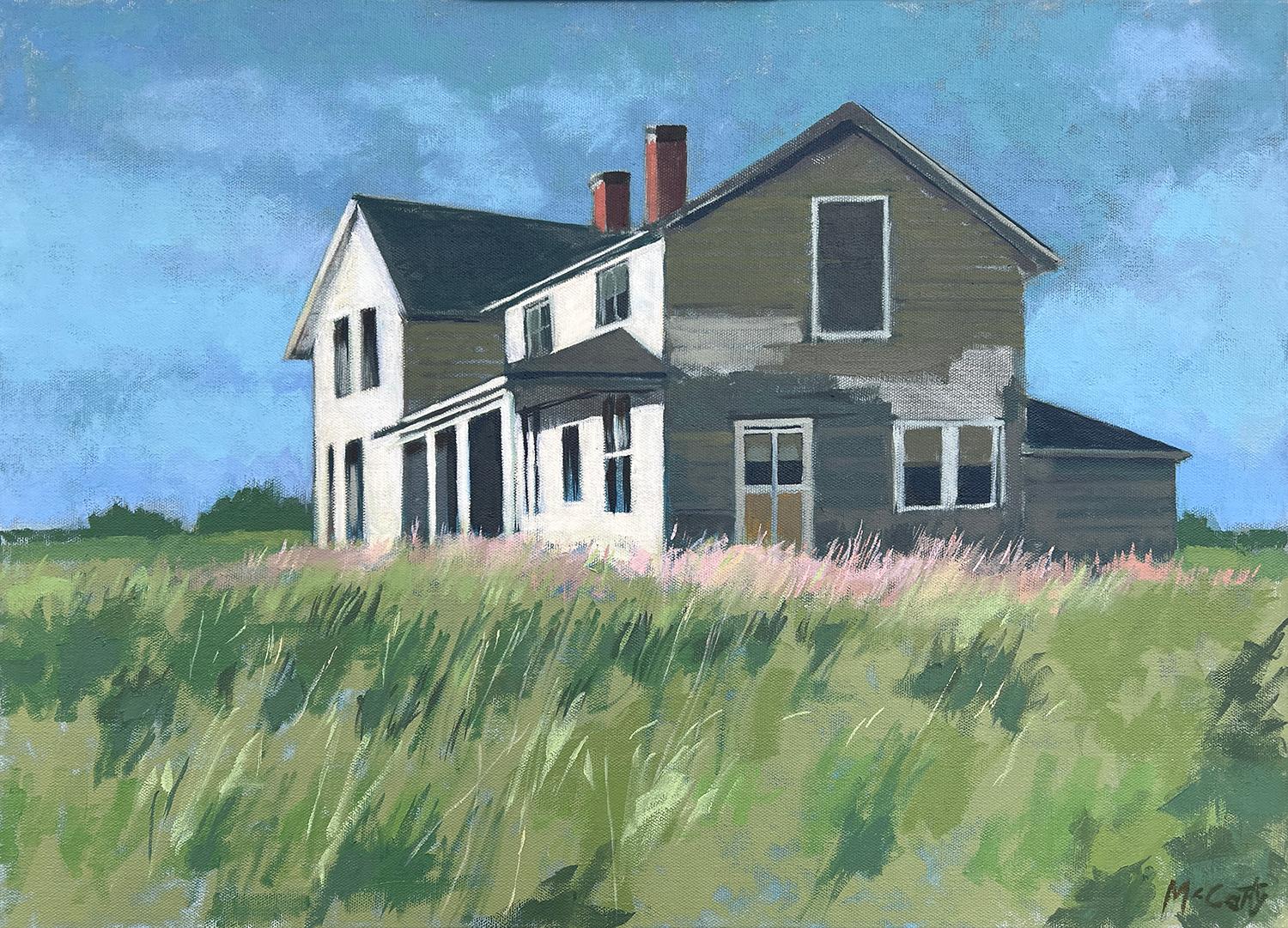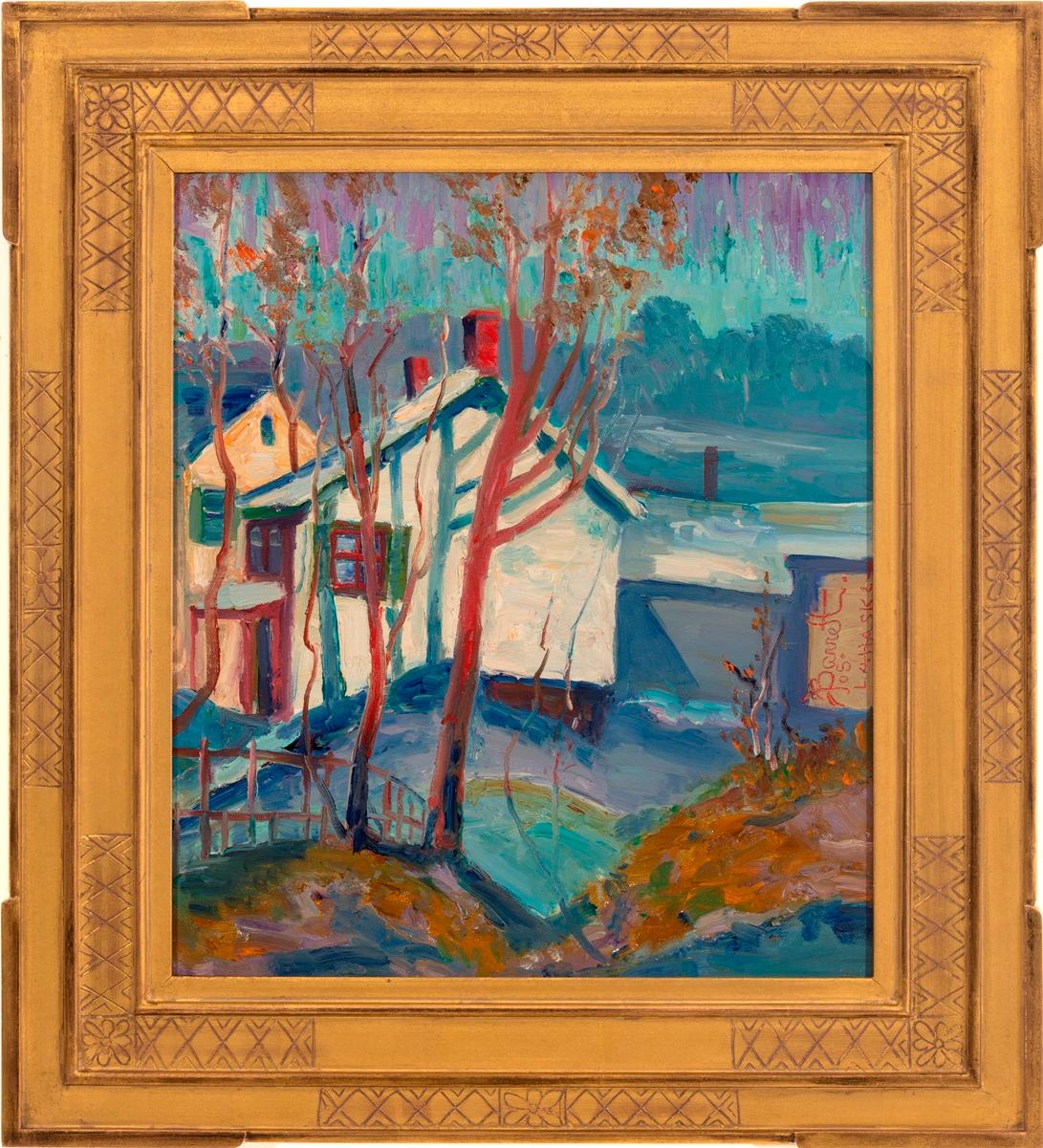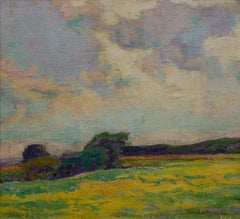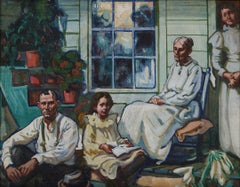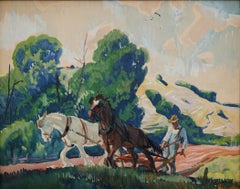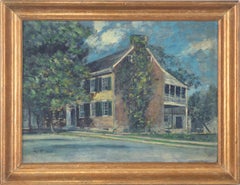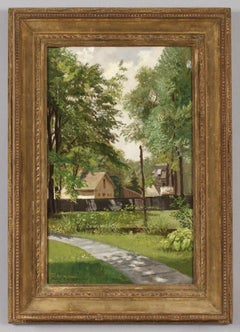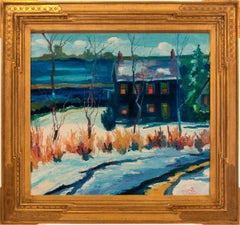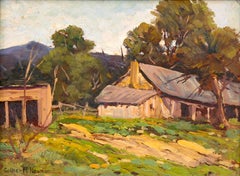Items Similar to House in Hudson, Ohio, Late 19th Century Painting by Cleveland School Artist
Video Loading
Want more images or videos?
Request additional images or videos from the seller
1 of 17
Ora ColtmanHouse in Hudson, Ohio, Late 19th Century Painting by Cleveland School Artist
$6,250
£4,742.36
€5,422.46
CA$8,729.56
A$9,706.08
CHF 5,067.98
MX$118,146.60
NOK 64,665.20
SEK 60,588.20
DKK 40,468.82
Shipping
Retrieving quote...The 1stDibs Promise:
Authenticity Guarantee,
Money-Back Guarantee,
24-Hour Cancellation
About the Item
Ora Coltman (American, 1858-1940)
House in Hudson, OH
Oil on canvas
Signed lower left
22 x 26 inches
27.5 x 31.5 inches, framed
21 Aurora Street is locally known as the Isham-Beebe House because the Isham family built the home and the Beebe family were long time occupants. It was built in 1832/33 by Leander Starr (1804-1885). Warren Isham (1798-1863) was the publisher of the "Hudson Observer and Telegraph," which had a circulation of 1400 in 1831. His son, Warren Parsons Isham (1831-1863), was born and raised in this home and went on to be the assistant editor of the "Chicago Times" and later was shipwrecked on Lake Superior. The Greek Revival structure has original timbers in the attic and original plaster over split lathe in some areas. The present entrance on Aurora Street was modified and not of the original construction. During the 1850s successful merchant and former Hudson Mayor, Anson Brewster (1807-1864) bought the property and gifted it to his daughter, Ellen Brewster Beebe (1836-1912) and son-in-law and Hudson Mayor, David Duncan Beebe (1831-1889) as a wedding gift. Christ Church Episcopal acquired the architectural gem during the 1940s.
Ora Coltman was born in 1858 in Shelby, Ohio, but spent most of his working artistic life in Cleveland, and is considered to be a Cleveland artist.
He was a painter, block printer, sculptor, muralist, architect, teacher, and writer.
In the 1880's Coltman came to Cleveland to study law, but abandoned that career to become an artist. He worked as a designer at the Joseph Carabelli Monument Works.
He Studied at the Cleveland School of Art (The Cleveland Institute of Art) with William Merritt Chase at the Art Students League in New York City, and at the Academie Julian in Paris.
Coltman's first solo exhibition was in 1902 at the Case Library. He exhibited at the Art Institute of Chicago in 1900, 1903, 1911, 1929, 1932. Additionally, at the Society of Independent Artists, and Pennsylvania Academy of Fine Art in Philadelphia from 1925-32. He exhibited in annual Cleveland artists' and craftsmen's shows, in oil, watercolor and pastel. Also at the Copley Society in Boston, and the Corcoran Gallery in Washington. His works were exhibited at the Cleveland Museum of Art in the May Show from 1922-1940.
After 1918 he began spending summers painting in Provincetown, Massachusetts. His best friend was George Adomeit, and they often painted together in the environs of Cleveland and in Provincetown as well. Coltman was famous in the Little Italy neighborhood of Cleveland, where he had a studio. Coltman Road was named for him.
He was a member of the Cleveland Society of Artists and Cleveland Printmakers.
His works are exhibited at the Cleveland Museum of Art, The Butler Institute of American Art in Youngstown, Ohio.
He created a full size wall mural for the Cleveland Public Library entitled "Dominance of the City."
"Coltman produced Dominance of the City between 1933 and 1934. It was the first New Deal mural commissioned in Cleveland. The New Deal was a federal program under the direction of the Treasury Department. The first program put into effect under the New Deal was the Public Works of Art Project (PWAP), and it ran from December 1933 to June 1934. The purpose of PWAP was to employ struggling artists to create art scenes of American life for public and government buildings. Coltman’s contribution was Dominance of the City, a mural triptych. A triptych is comprised of three separate and distinct panels. In this work, each section depicts a specific area of Cleveland. The largest part, the middle segment, displays a bridge rising over the Cuyahoga River in the Flats. The left portion is a painting of the Ohio Bell building, and the right panel portrays the St. Theodosius Church, which can be found in the Tremont neighborhood. It is a beautiful and thoughtful piece of art which came from a talented and unique artist in a resilient city full of treasures and possibilities.
Dominance of the City can be found at the Cleveland Public Library Main Branch on the 3rd Floor in the CD Room.”
- Creator:Ora Coltman (1858 - 1940, American)
- Dimensions:Height: 27.5 in (69.85 cm)Width: 31.5 in (80.01 cm)
- Medium:
- Movement & Style:
- Period:
- Condition:
- Gallery Location:Beachwood, OH
- Reference Number:1stDibs: LU1768215756472
About the Seller
5.0
Vetted Professional Seller
Every seller passes strict standards for authenticity and reliability
Established in 1975
1stDibs seller since 2022
34 sales on 1stDibs
Typical response time: 1 hour
- ShippingRetrieving quote...Shipping from: Beachwood, OH
- Return Policy
Authenticity Guarantee
In the unlikely event there’s an issue with an item’s authenticity, contact us within 1 year for a full refund. DetailsMoney-Back Guarantee
If your item is not as described, is damaged in transit, or does not arrive, contact us within 7 days for a full refund. Details24-Hour Cancellation
You have a 24-hour grace period in which to reconsider your purchase, with no questions asked.Vetted Professional Sellers
Our world-class sellers must adhere to strict standards for service and quality, maintaining the integrity of our listings.Price-Match Guarantee
If you find that a seller listed the same item for a lower price elsewhere, we’ll match it.Trusted Global Delivery
Our best-in-class carrier network provides specialized shipping options worldwide, including custom delivery.More From This Seller
View AllEarly 20th Century Landscape with Covered Bridge, Female Cleveland School Artist
By May Ames
Located in Beachwood, OH
May Lydia Ames (American, 1863-1943)
Landscape with Covered Bridge
Oil on canvas
Signed lower left
9.75 x 8 inches
14.5 x 13 inches, framed
May Ames was born in Cleveland in 1863 an...
Category
Early 20th Century American Impressionist Figurative Paintings
Materials
Oil
Early 20th Century Summer Landscape, Cleveland School Artist
By George Adomeit
Located in Beachwood, OH
George Gustav Adomeit (American, 1879-1967)
Summer Landscape
Oil on canvas board
Signed lower right
13 x 14.25 inches
18.25 x 19.5 inches, framed
A major painter of American scene s...
Category
Early 20th Century American Modern Figurative Paintings
Materials
Oil
On the Back Porch, Brecksville, Ohio, Early 20th Century Regionalist Scene
By Frank Wilcox
Located in Beachwood, OH
Frank Nelson Wilcox (American, 1887-1964)
On the Back Porch, Brecksville, Ohio, c. 1922
Watercolor on paper
Monogram lower right
21.5 x 27. 5 inc...
Category
1920s American Modern Figurative Paintings
Materials
Watercolor
Plowman, Brecksville, Ohio, Early 20th Century Farm Landscape, Cleveland School
By Frank Wilcox
Located in Beachwood, OH
Frank Nelson Wilcox (American, 1887–1964)
Plowman, Brecksville, Ohio, c. 1922
Watercolor on paper
Signed lower right
22.5 x 27.75 inches
27.75 x 34.5 inches, framed
Frank Nelson Wilcox (October 3, 1887 – April 17, 1964) was a modernist American artist and a master of watercolor. Wilcox is described as the "Dean of Cleveland School painters," though some sources give this appellation to Henry Keller or Frederick Gottwald. Wilcox was born on October 3, 1887 to Frank Nelson Wilcox, Sr. and Jessie Fremont Snow Wilcox at 61 Linwood Street in Cleveland, Ohio. His father, a prominent lawyer, died at home in 1904 shortly before Wilcox' 17th birthday. His brother, lawyer and publisher Owen N. Wilcox, was president of the Gates Legal Publishing Company or The Gates Press. His sister Ruth Wilcox was a respected librarian.
In 1906 Wilcox enrolled from the Cleveland School of Art under the tutelage of Henry Keller, Louis Rorimer, and Frederick Gottwald. He also attended Keller's Berlin Heights summer school from 1909. After graduating in 1910, Wilcox traveled and studied in Europe, sometimes dropping by Académie Colarossi in the evening to sketch the model or the other students at their easels, where he was influenced by French impressionism. Wilcox was influenced by Keller's innovative watercolor techniques, and from 1910 to 1916 they experimented together with impressionism and post-impressionism. Wilcox soon developed his own signature style in the American Scene or Regionalist tradition of the early 20th century. He joined the Cleveland School of Art faculty in 1913. Among his students were Lawrence Edwin Blazey, Carl Gaertner, Paul Travis, and Charles E. Burchfield. Around this time Wilcox became associated with Cowan Pottery.
In 1916 Wilcox married fellow artist Florence Bard, and they spent most of their honeymoon painting in Berlin Heights with Keller. They had one daughter, Mary. In 1918 he joined the Cleveland Society of Artists, a conservative counter to the Bohemian Kokoon Arts Club, and would later serve as its president. He also began teaching night school at the John Huntington Polytechnic Institute at this time, and taught briefly at Baldwin-Wallace College.
Wilcox wrote and illustrated Ohio Indian Trails in 1933, which was favorably reviewed by the New York Times in 1934. This book was edited and reprinted in 1970 by William A. McGill. McGill also edited and reprinted Wilcox' Canals of the Old Northwest in 1969. Wilcox also wrote, illustrated, and published Weather Wisdom in 1949, a limited edition (50 copies) of twenty-four serigraphs (silk screen prints) accompanied by commentary "based upon familiar weather observations commonly made by people living in the country."
Wilcox displayed over 250 works at Cleveland's annual May Show. He received numerous awards, including the Penton Medal for The Omnibus, Paris (1920), Fish Tug on Lake Erie (1921), Blacksmith Shop (1922), and The Gravel Pit (1922). Other paintings include The Trailing Fog (1929), Under the Big Top (1930), and Ohio Landscape...
Category
1920s American Modern Figurative Drawings and Watercolors
Materials
Watercolor
Landscape Scene with Barn and Trees, Late 19th Century, Ohio Artist
By Addison Thomas Millar
Located in Beachwood, OH
Addison Thomas Millar (American, 1860-1913)
Barn scene, 1892
Oil on board
Signed and dated lower left
10.25 x 13.5 inches
15 x 18.5 inches, framed
Addison Thomas Millar was an American painter and artist; best known for his genre scenes and Orientalist paintings.
He was born to William H. Millar and Permelia Kennedy Millar. His father had emigrated to the United States from Scotland in 1845. He grew up in Warren, Ohio. During his primary education, he took some painting lessons from John Bell, a local landscape painter.
In his late teens, he won three consecutive awards from The Youth's Companion, in their annual art contests. This prompted his parents to allow him to go to Cincinnati to take formal lessons from the genre painter, De Scott Evans...
Category
1890s Landscape Paintings
Materials
Oil
Hillside and Stream, early 20th century modernist Cleveland School painting
Located in Beachwood, OH
Clara Deike (American, 1881-1964)
Hillside and Stream, 1916
Gouache on paper
Signed and dated lower right
22 x 18 inches
25.5 x 21.5 inches, framed
A graduate of the Cleveland Schoo...
Category
1910s American Modern Figurative Paintings
Materials
Gouache
You May Also Like
Historical Home Russellville Kentucky 1930
Located in Soquel, CA
Mid-century Southern landscape of the historical Home possibly of the Artist and built by the Kentucky Governor John Breathitt for his daughter Jane (some historical accounts say) and later the McClean family lived there, in Russellville, Kentucky by Roberta Fisk McClean (American, 1882-1975). As we get the information confirmed we will update the description. Roberta painted numerous versions of the house and one example called it the Bowden House. There is a House that looks similar on E5th in Russellville called Governors Corner, but many look like the same structure of the time.
Signed "R. McClean" in the lower left corner
Presented in a giltwood frame.
Artist's board size: 14"H x 19"W
Framed size: 17.75"H x 22.5"W
Born in Russellville, Kentucky, Roberta McClean...
Category
Mid-20th Century Realist Landscape Paintings
Materials
Canvas, Oil, Board
House and Garden, Morristown NJ, 1908 by Frank Waller
By Frank Waller
Located in Philadelphia, PA
Frank Waller
(American, 1842-1923)
House and Garden, Morristown, 1908
Oil on canvas, 18 1/2 x 12 inches
FRAMED: 24 1/2 x 18 inches (approx.)
Dated and in...
Category
Early 1900s Realist Landscape Paintings
Materials
Canvas, Oil
"House, Lahaska"
By Joseph Barrett
Located in Lambertville, NJ
Illustrated in "Joseph Barrett, The Prime Years 1970s - 1990s", pg. 7 #007
Jim’s of Lambertville is proud to offer this artwork by:
Joseph Barrett (1936 – )
Joseph Barrett wa...
Category
Late 20th Century American Impressionist Landscape Paintings
Materials
Canvas, Oil
Old House, Built in 1848
By Gilbert Neumann
Located in Austin, TX
"Old House, Built in 1848" by painter Gilbert F. Neumann
Medium: Oil paint on panel
Size: 9 x 12 inches
Frame Size: 14 x 18.5 inches
A nostalgic painting of ...
Category
20th Century American Impressionist Landscape Paintings
Materials
Oil, Panel
Old House, Oil Painting
By Brian McCarty
Located in San Francisco, CA
Artist Comments
A country house stands solitary in an overgrown field, with traces of time passing evident in its exterior. The grass dances with the wind as the summer sky g...
Category
21st Century and Contemporary Impressionist Interior Paintings
Materials
Oil
"Cottage in Lahaska"
By Joseph Barrett
Located in Lambertville, NJ
Illustrated in "Joseph Barrett, The Prime Years 1970s - 1990s", pg. 10 #011
Jim’s of Lambertville is proud to offer this artwork by:
Joseph Barrett (1936 – )
Joseph Barrett was born in Midland, North Carolina, in 1936 and studied at the Massachusetts College of Art in Boston and at the Tyler School of Art in Philadelphia. Barrett, now of Lahaska, Pennsylvania, has been painting his entire adult life. His favorite subjects include the landscape surrounding New Hope and many local landmarks often encompassing figures into his compositions. Barrett utilizes a heavy impasto and his palette bears similarities to that of Fern Coppedge and George Sotter. Barrett’s paintings are always found in unique and somewhat charming handmade frames designed by the artist and finished in metal leaf.
A living contemporary of the no longer living “New Hope School” impressionist painters, Joseph Barrett resides outside of New Hope above his old-fashioned antique shop and studio. Entering Barrett’s shop is like taking a step back in time. Inside this cluttered and dusty haven of treasures from the past, is a studio spanning only four by eight feet. This little studio, containing cans of old brushes and hundreds of used paint tubes...
Category
Late 20th Century American Impressionist Landscape Paintings
Materials
Canvas, Oil
More Ways To Browse
Wedding In Paintings
Antique Greek Painting
19th Century Pastel Painting
19th Century Greece Painting
19th Century Hudson River School Paintings
William Bell
Lake George Painting
19th Century Paris Street Scene
Shipwreck Antique
1911 Antiques
S Warren Art
St Julians
Warren Long
Church Bell
Lake George Oil Painting
1850s Oil Paintings
Antique George Washington Painting
1940s Plaster
